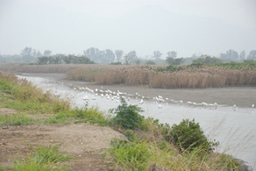Unconventional (Anti)Ferroelectricity in Van der Waals Group-IV Monochalcogenides

When we first embarked on this research journey, our goal was to explore the potential of van der Waals (vdW) layered materials for next-generation nanodevices. Specifically, we were intrigued by the possibility of discovering new ferroelectric (FE) materials that could break the traditional symmetry limitations. Ferroelectrics are typically required to belong to a noncentrosymmetric space group, which significantly limits the scope of materials that can exhibit ferroelectricity. Our work, however, took a different path by uncovering an unconventional antiferroelectricity (AFE) in centrosymmetric vdW materials, specifically in the group-IV monochalcogenide GeSe, and triggering lattice-distortion-induced ferroelectricity under external electric fields.

The Genesis of the Idea
The initial spark for this research came from the growing interest in vdW materials, which have shown remarkable electronic, optical, and mechanical properties due to their layered structure and weak interlayer interactions. While many vdW materials exhibit in-plane ferroelectricity, out-of-plane (OOP) ferroelectricity is rare, especially in centrosymmetric materials. We wondered: Could there be a hidden form of OOP ferroelectricity or antiferroelectricity in these materials that has been overlooked?
Our hypothesis was that by inducing structural distortions, we could trigger ferroelectricity in materials that are traditionally considered non-ferroelectric due to their centrosymmetric nature. This idea led us to focus on GeSe, a representative member of the group-IV monochalcogenides, which had previously shown interesting in-plane ferroelectric properties but had not been explored for OOP ferroelectricity.
Challenges and Breakthroughs
One of the biggest challenges we faced was the experimental verification of our theoretical predictions. While first-principles calculations suggested that GeSe could exhibit intrinsic OOP antiferroelectricity, confirming this experimentally requires precise control over the material’s structure and electric field application. We had to develop new techniques to measure the OOP polarization and observe the structural changes at atomic-level.
The breakthrough came when we successfully performed piezoresponse force microscopy (PFM) measurements on GeSe flakes. These experiments revealed distinctive hysteresis loops, confirming the presence of OOP ferroelectricity. Moreover, we observed a transition from antiferroelectric to ferroelectric behavior under an external electric field, which aligned perfectly with our theoretical predictions.
Another significant challenge was the in-situ observation of atomic-level structural changes. Using high-angle annular dark-field scanning transmission electron microscopy (HAADF-STEM), we were able to capture the dynamic evolution of GeSe’s atomic structure under an applied electric field. This allowed us to directly visualize the asymmetric ion displacements that drive the AFE-FE transition, providing concrete evidence for our proposed mechanism.
Personal Anecdotes and Untold Stories
One of the most memorable moments in this research was when we first observed the double hysteresis loops in the PFM measurements. It was a late night in the lab, and we had been running experiments for hours, trying to fine-tune the parameters to get a clear signal. When the double loops finally appeared on the screen, there was a collective moment of excitement and relief. It was a clear sign that we were on the right track, and it motivated us to push forward with the rest of the experiments.
Another story is the collaborative effort that went into this work. Our team included experts in theoretical calculations, experimental physics, and materials science. The synergy between these different areas of expertise was crucial in overcoming the challenges we faced. For example, the theoretical team’s predictions guided the experimental team’s approach, while the experimental results provided feedback that refined the theoretical models. This iterative process was key to the success of the project.
Implications for Future Research
Our findings open up new avenues for exploring ferroelectricity in centrosymmetric vdW materials. By demonstrating that the OOP antiferroelectricity is intrinsic and can be controlled to be ferroelectric in GeSe, we have shown that the traditional symmetry constraints on ferroelectric materials can be circumvented. This has significant implications for the design of new ferroelectric materials, particularly for applications in low-power electronics, nonvolatile memory, and in-memory computing.
Moreover, our work suggests that the group-IV monochalcogenides, and potentially other centrosymmetric vdW materials, could be a rich source of unconventional ferroelectricity. Future research could explore the possibility of similar behavior in other materials, as well as the potential for tuning the ferroelectric properties through external stimuli such as strain, doping, or electric fields.
Conclusion
This research journey has been both challenging and rewarding. By combining theoretical insights with cutting-edge experimental techniques, we were able to uncover a hidden form of antiferroelectricity in GeSe and demonstrated its potential for ferroelectric applications. We hope our work will inspire further exploration of unconventional ferroelectricity in vdW materials and lead to new breakthroughs in the field of nanodevices.
As we look to the future, we are excited about the possibilities that lie ahead. The field of vdW materials is still in its infancy, and there is much more to discover. We believe that our findings are just the beginning, and we look forward to seeing where this research will take us next.
We would like to thank our collaborators, funding agencies, and the entire research team for their invaluable contributions to this work. Special thanks to Professors A. M. Rappe and X. G. Wan for their insightful discussions and guidance throughout the project.
This work is titled as “Unconventional (Anti)Ferroelectricity in Van der Waals Group-IV Monochalcogenides” and published in the latest issue of Nature Communications (https://doi.org/10.1038/s41467-025-57138-5).
Follow the Topic
-
Nature Communications

An open access, multidisciplinary journal dedicated to publishing high-quality research in all areas of the biological, health, physical, chemical and Earth sciences.
Related Collections
With Collections, you can get published faster and increase your visibility.
Women's Health
Publishing Model: Hybrid
Deadline: Ongoing
Advances in neurodegenerative diseases
Publishing Model: Hybrid
Deadline: Dec 24, 2025




Please sign in or register for FREE
If you are a registered user on Research Communities by Springer Nature, please sign in